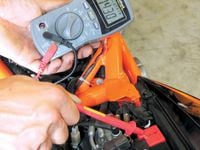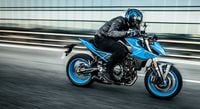QUESTION: Your Road Test spec charts are very thorough in terms of a bike's performance, dimensions, weight, and stuff like that. But one number I never see is alternator output. This probably isn't an important spec for sportbikes, but this number is useful for those of us who like to add electrical accessories—heated clothing, GPS, audio systems—to our bikes. Why don't you include alternator output in the specs charts?
Sheila Hobbes, Canby, OR
Do you have a tech question that you'd like an answer for? Email us at mcmail@bonniercorp.com with "Answers" in the subject line.
ANSWER: We don't currently list alternator output in spec charts because this figure is usually hard to get from the manufacturers. And even if we know the charging system's maximum output (which, by the way, is in the owner's manual, but our testbikes normally do not come with this document), that's only part of the equation. The charging system has to run the vehicle with enough left over to recharge the battery after engine start. How much juice does your bike require just to run? We've yet to see a spec in the manual to indicate that.
But we’re not going to leave you without an answer. First, see if your bike has an accessory circuit. Many do, usually fuse-protected at 5, 10, or 15 amps. Almost certainly, you can add that much and still be under the total charging system’s limit. Second, you can run a simple test. Connect a digital voltmeter to the battery terminals. Start the bike and rev the engine to an rpm equivalent to a slow highway speed. Begin turning on the accessories. The battery voltage should remain steady until the charging-system capacity is reached, and then it will decline. You’re looking for no less than 13.8 volts across the battery because this is what it takes to charge it. If at a cruise rpm you still have 13.8 volts (or close to that), you’re good. Now let the engine idle. Watch the voltage. You might have to turn a few of those accessories off to keep the voltage where you want it. Remember that under this load the battery is charging on the highway but discharging (if the voltage is at or below 12.6 volts) at idle.

/cloudfront-us-east-1.images.arcpublishing.com/octane/HT5PNEQC7VDXZHNYECPSKSYGTU.jpg)
/cloudfront-us-east-1.images.arcpublishing.com/octane/VN63PLIOMJCDJC3PWLIJQI5YHQ.jpg)
/cloudfront-us-east-1.images.arcpublishing.com/octane/SYIS3UGL7BGB5NEN5GSIVSFISM.jpg)
/cloudfront-us-east-1.images.arcpublishing.com/octane/H2NJJMCBSZCVHNDOGUQILJFMX4.jpg)
/cloudfront-us-east-1.images.arcpublishing.com/octane/K25WVPRMCVEDZJ7ZJK4BWE374Y.jpg)
/cloudfront-us-east-1.images.arcpublishing.com/octane/TQQGTGULURF5TOSK4FHQX7QKWY.jpg)

/cloudfront-us-east-1.images.arcpublishing.com/octane/THZ26BIH45AYBHU6WB527JTTCU.jpg)
/cloudfront-us-east-1.images.arcpublishing.com/octane/7OWQWAWJBFCGTAYQWBMWGNMNB4.jpg)
/cloudfront-us-east-1.images.arcpublishing.com/octane/4G5XKCDIHRCGRHVF7OPORG7ZX4.jpg)
/cloudfront-us-east-1.images.arcpublishing.com/octane/D2BDYKKNZ5GRHGDMI4PZTGRMME.jpg)

/cloudfront-us-east-1.images.arcpublishing.com/octane/UAY4WSZPOFDQRP4MCEXAKDFQOQ.jpg)

/cloudfront-us-east-1.images.arcpublishing.com/octane/X5CE3KSJHZHM5CUFGPZ7U26WB4.jpg)
/cloudfront-us-east-1.images.arcpublishing.com/octane/COWLTPGFAFGDDGJCTENYMA4VJM.jpg)
/cloudfront-us-east-1.images.arcpublishing.com/octane/H3PKUGPSUJFTND4RFPSI4OIDCE.jpg)
/cloudfront-us-east-1.images.arcpublishing.com/octane/UHGQA3MQDFCA3HLBWF7S76WH6Y.jpg)
/cloudfront-us-east-1.images.arcpublishing.com/octane/Q5EORCSTNFAVBJC4IYUHIKJTXQ.jpg)
/cloudfront-us-east-1.images.arcpublishing.com/octane/XIJ5FUFSP5A3NL7MOVZGJXAHC4.jpg)
/cloudfront-us-east-1.images.arcpublishing.com/octane/V5NZN3CGS5B5PPYFYJHIPAU5S4.jpg)
/cloudfront-us-east-1.images.arcpublishing.com/octane/CZE6ONOBU5E7HPIEEADU376C4M.jpg)
/cloudfront-us-east-1.images.arcpublishing.com/octane/UT4KL3SIYJBSPNHWJXTBE6MTGE.jpg)
/cloudfront-us-east-1.images.arcpublishing.com/octane/Q3UOIDZ22ZEVDBZUWGJXIMGJKI.jpg)